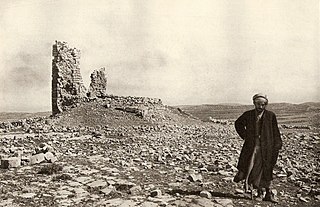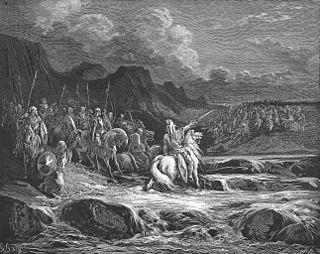1 Maccabees, also known as the First Book of Maccabees, First Maccabees, and abbreviated as 1 Macc., is a deuterocanonical book which details the history of the Maccabean Revolt against the Seleucid Empire as well as the founding and earliest history of the independent Hasmonean kingdom. It describes the promulgation of decrees forbidding traditional Jewish practices by King Antiochus IV Epiphanes and the formation of a rebellion against him by Mattathias of the Hasmonean family and his five sons. Mattathias's son Judas Maccabeus takes over the revolt and the rebels as a group are called the Maccabees; the book chronicles in detail the successes and setbacks of the rebellion. While Judas is eventually killed in battle, the Maccabees eventually achieve autonomy and then independence for Judea under the leadership of the Hasmonean family. Judas's brother Simon Thassi is declared High Priest by will of the Jewish people. The time period described is from around 170 BC to 134 BC.
2 Maccabees, also known as the Second Book of Maccabees, Second Maccabees, and abbreviated as 2 Macc., is a deuterocanonical book which recounts the persecution of Jews under King Antiochus IV Epiphanes and the Maccabean Revolt against him. It concludes with the defeat of the Seleucid Empire general Nicanor in 161 BC by Judas Maccabeus, the leader of the Maccabees.

Judah Maccabee was a Jewish priest (kohen) and a son of the priest Mattathias. He led the Maccabean Revolt against the Seleucid Empire.

The Battle of Beth Zechariah took place around May 162 BC during the Maccabean revolt fought between Jewish rebels under the leadership of Judas Maccabeus against an army of the Seleucid Empire, the Greek successor state (diadochi) to the Macedonian conquests that controlled Syria and Babylonia. The battle was fought at Beth Zechariah and was a Seleucid victory, with the rebels driven from the field in retreat. Judas's brother Eleazar Avaran died in combat with a war elephant. The defeat allowed the Seleucids to continue their campaign and besiege the Jewish holy city of Jerusalem.

The Battle of Elasa was fought in April 160 BCE during the Maccabean Revolt between Judean rebels led by Judas Maccabeus and an army of the Seleucid Empire under the command of Bacchides. The battle resulted in the triumph of the Greek Syrian forces, the defeat of the Maccabees, and the death of Judas Maccabeus.
Jason of Cyrene was a Hellenistic Jew who lived around the middle of the second century BCE. He is the author of a five-volume history of the Maccabean Revolt and its preceding events, which subsequently became a lost work. His history was preserved indirectly in an abridgment by an unknown Egyptian Jew, the book of 2 Maccabees, which was eventually included in the Septuagint, the Greek version of the Jewish scriptures. 2 Maccabees was eventually recognized as a deuterocanonical book included in the Catholic and Orthodox Christian biblical canon.
Alcimus, also called Jakeimos, Jacimus, or Joachim (Ἰάκειμος), was High Priest of Israel for three years from 162–159 BCE. He was a moderate Hellenizer who favored the ruling government of the Seleucid Empire and opposed the Maccabean Revolt which was in progress at the time.
Timothy was a military commander of the Seleucid Empire, active during the mid 2nd century BCE and probabaly a governor in the land of Ammon and Gilead. He fought during the Maccabee campaigns of 163 BC against the local Jews, and eventually the Maccabee rebel army themselves. He was eventually defeated by Judas Maccabeus at Dathema in Gilead.
Gorgias was a Syrian-Seleucid General of the 2nd century BC, in the service of Antiochus Epiphanes.

The Battle of Beth Horon or Battle with Seron was fought at some point between Spring 166 BC to Spring 165 BC during the Maccabean Revolt between Judean rebels led by Judas Maccabeus and an army of the Seleucid Empire under the command of Seron, a commander of the Syrian army. Beth-Horon, or Bethoron, was a strategic mountain pass leading from the coastal plain to the Judean hill country. Utilizing guerrilla warfare tactics, the Maccabee rebels ambushed the passing Seleucid force from the pass, pursuing the surprised and fleeing remnants into the plain.
The Battle of Adasa was fought during the Maccabean revolt on the 13th of the month Adar, 161 BC at Adasa, near Beth-horon. It was a battle between the rebel Maccabees of Judas Maccabeus and the Seleucid Empire, whose army was led by Nicanor. The Maccabees won the battle after killing Nicanor early in the fighting. The battle came after a period of political maneuvering over several months where the peace deal established a year earlier by Lysias was tested by the new High Priest Alcimus, the new military governor Nicanor, and the Maccabee leader Judas Maccabeus.

The Battle of Beth Zur was fought between the Maccabees led by Judas Maccabeus and a Seleucid Greek army led by Regent Lysias in October 164 BC at Beth Zur. According to the books of Maccabees, the rebels won the battle, although how significant this victory really was is disputed; it is possible the battle's result was inconclusive. Through a stroke of good fortune for the rebels, the days after the battle likely coincided with news of Seleucid King Antiochus IV Epiphanes's death reaching Judea; rather than continue the campaign, the Seleucid army and Lysias returned to the capital to handle the leadership transition. The Maccabees were able to capture Jerusalem soon after.
Bacchides was a Syrian-Greek general and governor (strategos) and friend and advisor (philoi) of King Demetrius I Soter of the Seleucid Empire. The Seleucid Empire was one of the Greek successor states (diadochi) founded after the conquests of Alexander the Great, and was centered in Syria and Babylonia in the Hellenistic era.
Adasa is a place referred to in the book 1 Maccabees, Chapter 7. The Aramaic language name used by the locals is not known, but was probably something like Ḥadaša. According to the passage, it was the site of the Battle of Adasa in year 151 of the Seleucid era, equivalent to 161 BCE. The battle was a victory for Judas Maccabeus's rebels in the Maccabean Revolt against the Seleucid Empire, and the Greek commander Nicanor died in battle.
Nicanor was a Syrian-Greek general (strategos) that served the Seleucid Empire during the reigns of kings Antiochus IV Epiphanes and Demetrius I Soter. He served during the Maccabean Revolt in Judea, then part of the Seleucid Empire, and served for a time as governor in Jerusalem. Relations between the government and the Jewish rebels eventually turned sufficiently hostile that he threatened the priests at the Second Temple and led an army to find and defeat Judas Maccabeus's followers, but he and his army were defeated at the Battle of Adasa. Nicanor was killed, his corpse was desecrated, his head and right hand hung for public display back in Jerusalem, and a new festival was declared to celebrate his defeat.
Lysias was a 2nd-century BC general and governor of Syria under the Seleucid Empire.

The Battle of the Ascent of Lebonah or Battle with Apollonius was the first battle fought between the Maccabees and the Seleucid Empire in 167 or 166 BCE. The Jewish forces were led by Judas Maccabeus and the Seleucid army force was under the command of Apollonius, described by Josephus as "the strategos (general) of the Samaritan forces".

The Maccabean Revolt was a Jewish rebellion led by the Maccabees against the Seleucid Empire and against Hellenistic influence on Jewish life. The main phase of the revolt lasted from 167 to 160 BCE and ended with the Seleucids in control of Judea, but conflict between the Maccabees, Hellenized Jews, and the Seleucids continued until 134 BCE, with the Maccabees eventually attaining independence.
Ptolemy Macron was a Greek official in the Hellenistic era. He first served the Ptolemaic Kingdom as governor of the island Cyprus. During the Sixth Syrian War between the Seleucid Empire under King Antiochus IV Epiphanes and the Ptolemaic Kingdom under King Ptolemy VI Philometor, he surrendered Cyprus to an invading Seleucid fleet, betraying the Ptolemies and joining the Seleucid Empire. Roman intervention to end the war would require that the Seleucids hand Cyprus back to the Ptolemies, meaning Ptolemy Macron thereafter served the Seleucids in their empire in Coele-Syria and Phoenicia as governor (strategos) there. However, with the death of King Antiochus IV and his replacement by Lysias as regent, he apparently fell out of favor with the Seleucid court. His death around 162 BCE was attributed to suicide.

During the Maccabean Revolt against the Seleucid Empire, there were a series of campaigns in 163 BC in regions outlying Judea - Ammon, Gilead, Galilee, Idumea, and Judea's coastal plain, a wider region usually referred to as either Palestine or Eretz Israel. The Maccabee rebels fought multiple enemies: Seleucid garrisons and hired mercenaries under a commander named Timothy of Ammon, non-Jewish inhabitants hostile to the Maccabees and their Jewish neighbors, and possibly the Tobiad Jews, a clan that generally favored the ruling Seleucid government. During 163 BC, the main Seleucid armies composed of Greeks were elsewhere, so the Maccabees were free to expand their influence against their neighbors.









